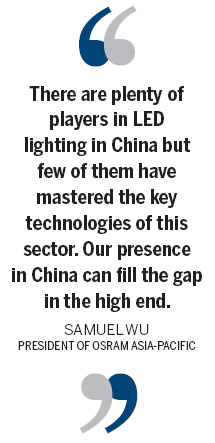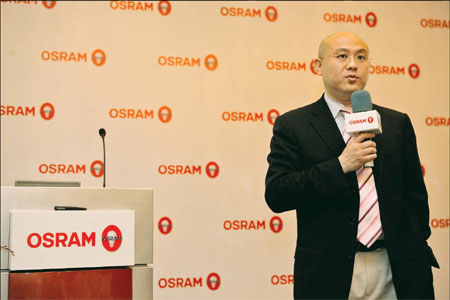Osram plans on a bright future
Updated: 2012-09-14 09:47
By Meng Jing (China Daily)
|
|||||||||||
|
Samuel Wu believes as LED technologies mature, the market will reward producers with top-tier technologies and high-quality products despite their relatively high prices. Provided to China Daily |
Germany-based company is investing heavily in China's LED market
When it comes to news about China's light-emitting diode industry, Osram AG Asia-Pacific President Samuel Wu is never in the dark. Since taking the helm of the regional operations of the world's second-largest lighting manufacturer in April, the former control engineer has eagerly devoured any news about the industry.
 |
One tidbit that recently attracted his attention was an article about the LED industry in South China's Guangdong province.
"It said that almost all the LEDs priced below 30 yuan ($4.73, 3.70 euros) were shown to be faulty to some extent in a test by local authorities in Guangzhou," Wu says, adding that this is a sign the sector in China is at an early stage, filled with low-quality and low-price products.
However, the seemingly immature LED industry in China has not scared Osram away. In August, the Germany-based company sped up its expansion by breaking ground on its first-ever LED-assembly plant in China, three months after it announced an investment plan in Wuxi, in East China's Jiangsu province.
"China is already the largest lighting market in the world with a significant growth potential in LED lighting. With China's LED lighting sector heading to a much healthier direction in the future, the market will reward producers with top-tier technologies and high-quality products despite their relatively high prices," Wu says.
LEDs, powered as they are by semiconductors, are notable for their performance in terms of energy efficiency, life span and environmental friendliness. As such, many scientists and companies say LEDs are set to transform the world's lighting industry.
Though China's LED market is going through a tough time, with news of LED-producers' bankruptcies and reduced sales frequently hitting headlines, Wu is a firm believer in a rosy future for his company's business.
Osram, the lighting subsidiary of the German conglomerate Siemens AG, does not only have more than 100 years of experience in providing lighting solutions but has also inherited around 8,000 LED patents, Wu says.
"There are plenty of players in LED lighting in China but few of them have mastered the key technologies of this sector. Our presence in China can fill the gap in the high end," he says.
The 100,000-square-meter Wuxi plant, which is scheduled for completion by the end of 2013, is Osram's fifth production base in China and the company's third LED production base worldwide, including its plants in Germany and Malaysia.
LED lighting is more accepted in developed countries due to its high price, but Wu emphasizes the new plant in Wuxi is in line with the company's "In China, for China" strategy.
He cites a recent market report from the global management-consulting firm McKinsey that said China's lighting market alone is worth more than 8 billion euros ($10 billion) today, which projected to more than double by 2020.
"The migration from conventional bulbs to LED lighting is a major driving force for the strong momentum in China," Wu says. He points out that China's LED-lighting sector is projected by McKinsey to be worth 11 billion euros by 2020, accounting for 20 percent of global revenue.
Wu refuses to disclose Osram's business performance in China or its share of the country's LED-lighting market as the company is on its way to a listing on a stock exchange scheduled for 2013. He does, however, reveal that one-fifth of the company's 5 billion euro revenue in 2011 was generated in the Asia-Pacific region, where it has more than 16,000 employees.
This is a larger workforce than what the company maintains anywhere else in the world, and roughly half of it is employed in China, according to public information from the company.
Some analysts say Osram's quick move to build an LED plant in China is designed to pave the way for its planned listing, which was put on hold by Siemens in September of last year, citing unfavorable stock-market conditions.
However, others say the large and potentially lucrative LED-lighting sector in China and the Chinese government's requirement for increasingly high levels of localization are the key reasons.
Wang Fei, a Shenzhen-based analyst with LEDinside, a unit under the consulting firm TrendForce, says the Chinese government is still a key supporter of the growth of the LED-lighting industry in China.
"Meeting the government's requirements is crucial for companies to get orders in China as large projects, such as urban lighting, are government controlled. And like anywhere in the world, the government in China is in favor of domestic production," Wang says.
China's Ministry of Science and Technology released its first Five-Year Plan for the semiconductor lighting industry (2011-15) in July, planning to have 80 percent of LED-lighting chips produced locally by 2015.
Osram's investment in Wuxi, which is near Shanghai, is an assembly plant packaging the chips it produces in Germany and Malaysia. But Wu doesn't rule out the possibility of bringing Osram's top-quality chips to China. He says there are some follow-up plans in the future but refuses to elaborate on them.
Osram is not the only world-class LED lighting giant that has shown a strong interest in China this year. In August, the Dutch multinational electronics company Philips also held a groundbreaking ceremony for its new 25 million euro LED Professional Lighting Solutions manufacturing facility in Southwest China's Sichuan province.
The current oversupply in China's LED lighting market has already burdened local producers, and the increasing number of foreign players has also raised concerns about intensified competition.
In an annual LED-lighting forum in Guangzhou in August, this year's theme was an LED world war, during which international companies were referred to as invaders.
However, Wu from Osram sees the company's engagement in China as more of cooperation rather than competition.
"The modules produced by our plant in Wuxi will not only be used by Osram but also sold to other companies downstream to help them produce high-end lighting products," he says, adding that there is a growing demand for high-quality LED-based products in China.
Liu Tong, manager of semiconductors and lighting with Beijing-based Tsinghua Tongfang, a local player in LED lighting, also tends to focus on the bright side.
"Of course there will be more competition but with the localization of the top international players, there will be unavoidable technology spillover, which will help further the development of China's LED-lighting sector," he says.
mengjing@chinadaily.com.cn
(China Daily 09/14/2012 page15)
Today's Top News
Rescuers race against time for quake victims
Telecom workers restore links
Coal mine blast kills 18 in Jilin
Intl scholarship puts China on the map
More bird flu patients discharged
Gold loses sheen, but still a safe bet
US 'turns blind eye to human rights'
Telecom workers restore links
Hot Topics
Lunar probe , China growth forecasts, Emission rules get tougher, China seen through 'colored lens', International board,
Editor's Picks

|

|

|

|

|

|






